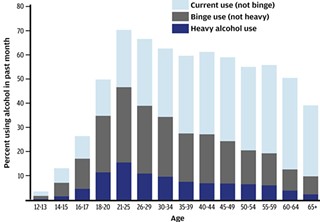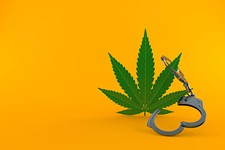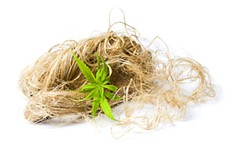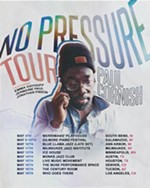Reefer Madness: Marijuana Still the No. 1 Hit
Drug warriors sidestep the issue of alcohol abuse
By Jordan Smith, Fri., Oct. 1, 2010

Stop the presses: Drug use among Americans (ages 12 and older) rose in 2009 to 21.8 million "current" users of illicit drugs, representing about 8.7% of the population. The increase is modest over 2008, when 8% of the population told the federal government about their illicit drug use, but all the hand-wringing among drug warriors would have you believe that everyone had picked up a joint to partake in a toke in aught-nine.
It is true that this is the first real uptick in drug use in about a decade – the rate has been hovering at the 8% mark since the early 2000s – but it's hardly anything to get too hung up about. Especially when you consider that the rate of illicit drug use – that is, according to the federal Substance Abuse and Mental Health Services Administration, the use of marijuana (and/or hash), cocaine (including crack), hallucinogens (all of 'em), heroin, inhalants (including, of course, glue), and the "nonmedical use" of prescription drugs – is nothing when compared to the use of alcohol, which a whopping 51.9% of Americans over the age of 12 currently use.
More on that in a minute. First, let's run down a few of the more interesting numbers related to illegal drug use. According to SAMHSA, drug use among kids 12-17 was up to 10% last year from 9.3% in 2008. More dramatic was the increase in drug use among fiftysomethings, which was 6.2% last year, up from 2.7% in 2002 – an increase which seems directly related to the aging of boomers who had a higher lifetime drug-use rate than the previous older cohorts. Use of cocaine by adults declined last year to 1.6% from 1.9% in 2008; use of prescription drugs was up to 7 million users, some 800,000 more than the previous year.
Not surprisingly, marijuana clocked in as the most commonly used illegal drug, with 16.7 million past-month users (that is, current users in the SAMHSA frame of reference). Interestingly, 76.6% of all illicit drug users use pot – and the majority of them use pot and only pot, according to SAMHSA, which would suggest we ram another nail into the coffin of the government's long-beloved marijuana "gateway drug" theory. Still, all those millions of users make up just 6.6% of the total U.S. population.
You might not guess that would be the case when you consider the number of people doing time in prison or jail for pot crimes. According to the FBI's Uniform Crime Report, released just two weeks ago, more than half of all drug arrests by police across the U.S. are related to pot, and a whopping 88% of the more than 850,000 pot arrests in 2009 were for possession only. (For what it's worth, the number of pot-related arrests peaked in 2007 at more than 872,000.) Given that the number of users keeps creeping up, it seems logical to conclude that trying to stop smokers by tossing them in jail is a tired – not to mention extremely expensive – approach to dealing with something that clearly isn't going away. "It's now more obvious than ever that decades of law enforcement efforts have absolutely failed to reduce marijuana's use or availability and that it's simply an exercise in futility to continue arresting hundreds of thousands of Americans for using something that's safer than alcohol," said Rob Kampia, executive director of the Marijuana Policy Project.
Drowning in Drink
And so the road leads back to alcohol. According to SAMHSA, not only are there roughly 131 million current drinkers (a number that has remained remarkably stable over the last decade), nearly 24% of those ages 12 and older engaged in "binge drinking" – five or more drinks at one sitting once per month – and nearly 7% of the population reported "heavy drinking" – which is binge drinking on at least five days in a 30-day period. Among the college-age cohort (18-25), those rates are even more dramatic: in 2009 41.7% were binge drinkers and 13.7% were heavy drinkers. And among teens (12-17), about one in 11 is a binge drinker.
So, what does this mean? It means, I think, that marijuana is hardly the most pervasive drug issue facing the U.S. Indeed, readers of "Reefer Madness" have read this before: Alcohol kills – and often. Let's start with the more than 23,000 who died of alcohol-induced deaths in 2007 (not counting accidents and murders), according to the Centers for Disease Control, add the more than 14,000 who died from alcohol-related liver disease that same year, and top it all off with the nearly 12,000 who died in alcohol-related traffic accidents in 2008, and what do you get? A lot of folks dead – from entirely preventable causes. But no one in their right mind would think of moving backward to Prohibition. That would be stupid. Why? Because prohibition doesn't work. And it's currently working equally well to control illicit drug use, which is to say it isn't working at all.
Still, in announcing the results of the yearly drug-use survey, no one in Washington (at least that I could find) stood up to say that alcohol use in America was particularly concerning. Instead, it was a parade of the typical. The survey's results concerning the number of current illicit drug users should serve as a "wake-up call" that past strategies for deterring drug use just don't work on "generation 'next,'" SAMHSA Administrator Pamela S. Hyde said in an agency press release. (Not that those "strategies" were particularly effective in the first place, considering the fact that we're still having these same discussions some four decades after the kickoff of the war on drugs.) Federal drug czar Gil Kerlikowske was equally dismayed by the illicit-drug-use numbers: "Today's findings are disappointing, but not surprising" (at least he got that part right) "because eroding attitudes and perceptions of harm about drug use over the past two years have served as warning signs for exactly what we see today," he said.
Perhaps it's time for these folks to sit down with a drink and figure out exactly what should be done to reverse this disturbing trend.
Got something to say on the subject? Send a letter to the editor.










